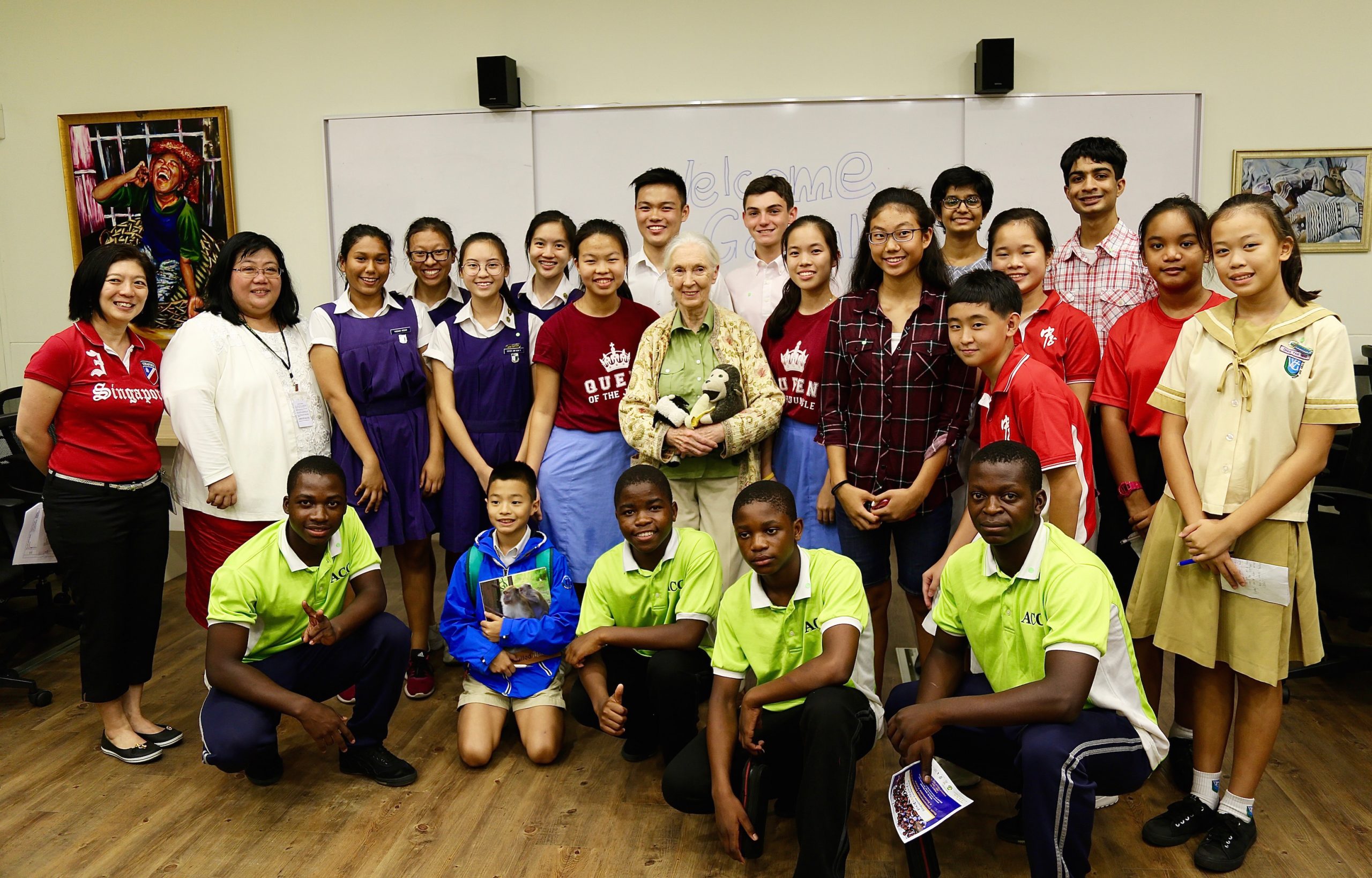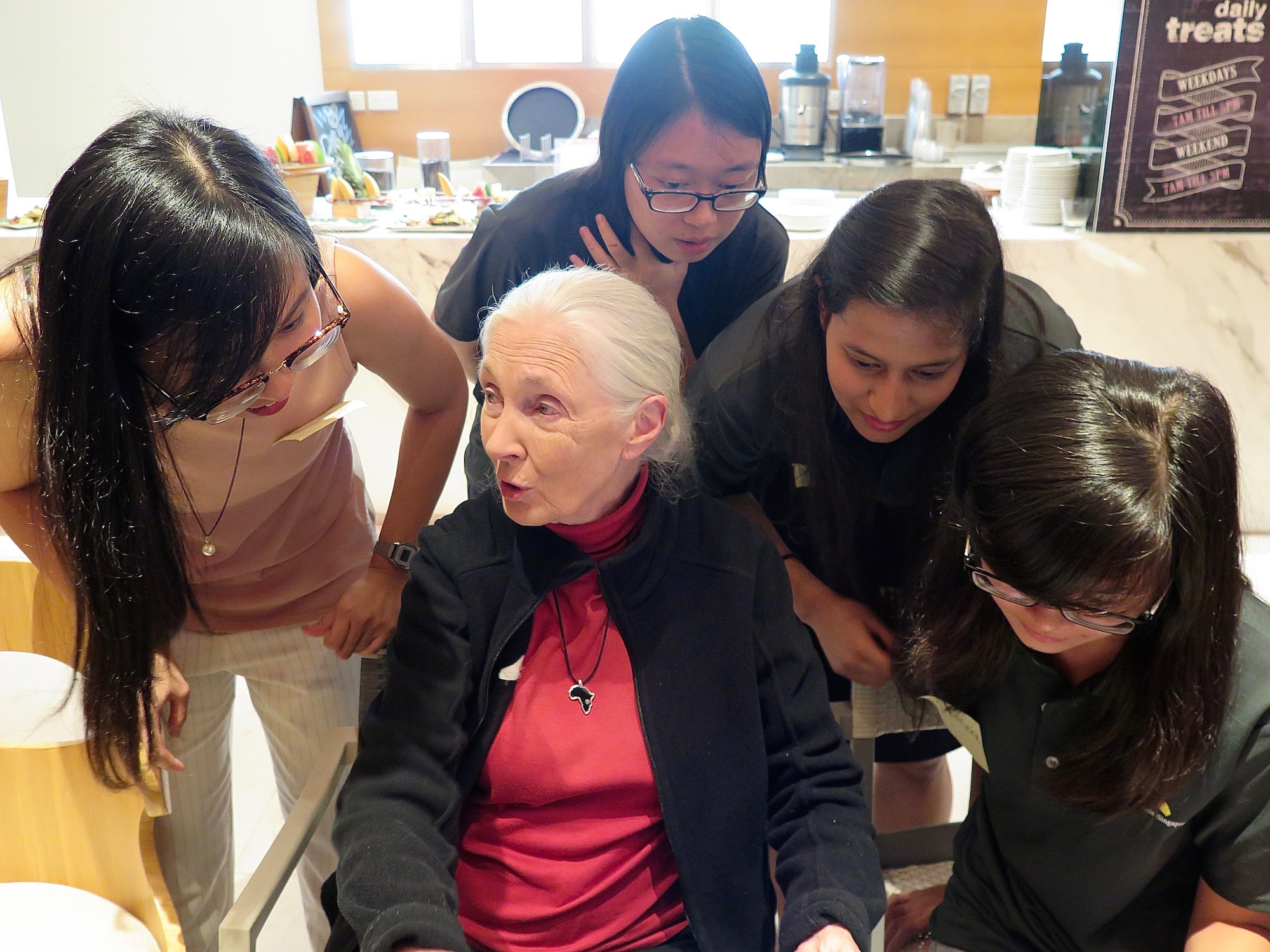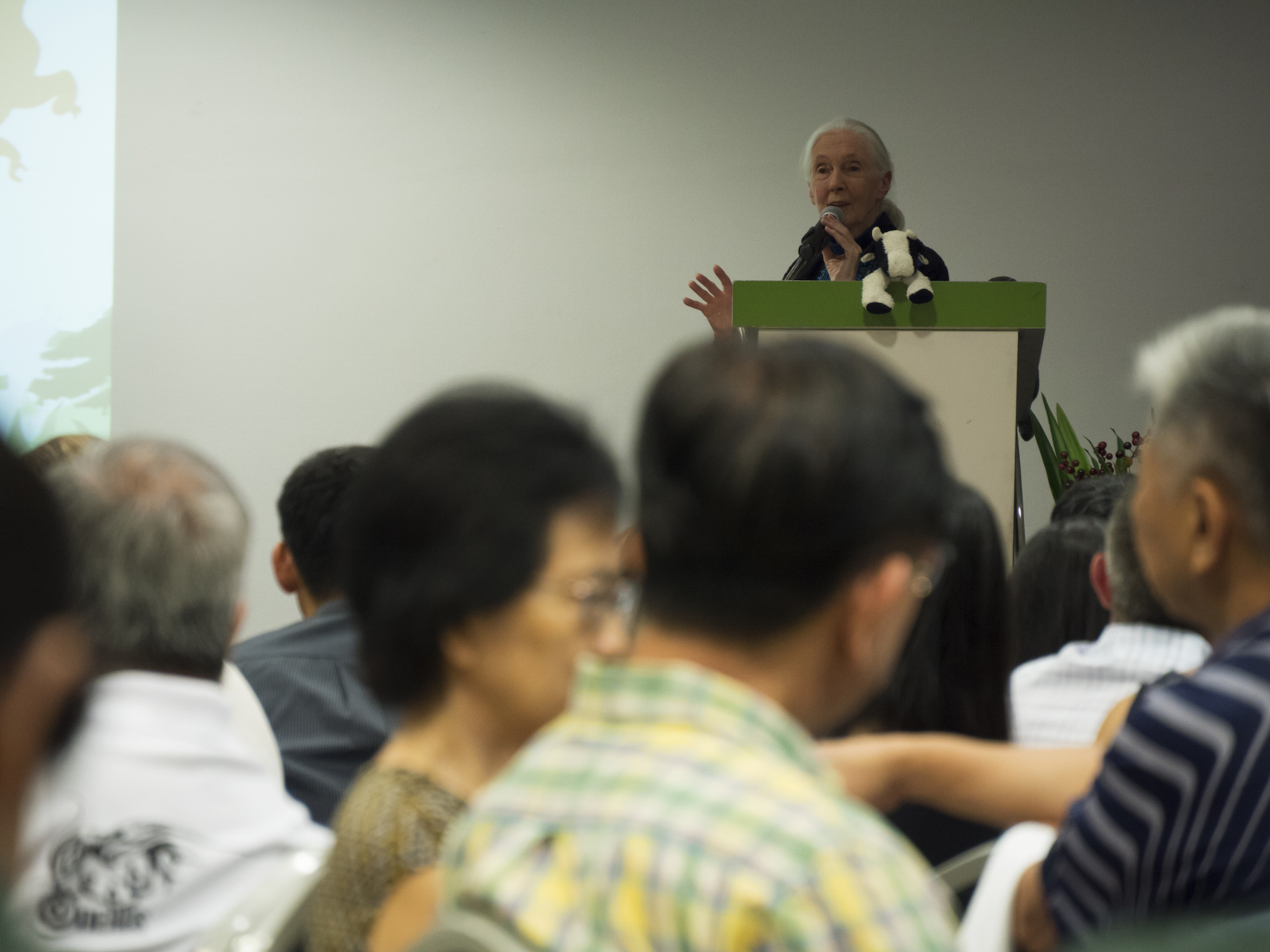
Held at the Singapore Chinese Girls school on the 8th of the August, the Roots & Shoots Conference 2017 that took place in the school’s auditorium during the 10th anniversary of the founding of the Jane Goodall Institute Singapore (JGIS) was one that hosted various guests who were gripped with anticipation over Dr Jane Goodall`s 8th visit to Singapore.
The theme for this year,
Youth Environmental Stewardship for a Sustainable Future.
A global humanitarian and environmental youth service learning programme that was founded by Dr. Jane and a group of 12 Tanzanian students, Roots & Shoots has since become a part of the learning journey of thousands of students across 100 nations who act to make the world a better place.
Celebrating its 26th year, an estimated 100 Roots & Shoots members were in attendance for the conference. Special guests in attendance were the 4 exchange students from Malawi that were the members that made up the 100th Roots & Shoots group that have joined the R&S family.
Greeted by a welcoming round of applause, Dr. Jane Goodall, accompanied by Minister for Social and Family Development Mr. Tan Chuan-Jin and board members of JGIS entered the auditorium. Dr. Jane`s smile was infectious to all those seated before her in the packed auditorium. Gracefully making her way to her seat in the front row, the excited audience surprised Dr. Jane with an array of animal calls.
The welcoming address by Mr. Tan Chuan-Jin highlighted the hands-on leadership and involvement of students in the various Roots & Shoots projects. As quoted from the minister`s speech,
“one of the heartening aspects of Roots & Shoots is that the projects are all initiated, designed and implemented by students.”
A phrase that resonated with the students and teachers from the R&S groups that were present. The quote was also a representation of the hard-work and effort made by the students as depicted by the exhibition located right outside the venue of student booths that were first showcased during this year’s Public Talk, as well as the 4 presentations that were to be delivered by students involved in the Roots & Shoots programme later in the conference.
Benz Chong, accompanied by his mother Madam Chen began his presentation on his research project on the behaviour of Macaques in the Bukit Timah Nature Reserve. His research question,
“What is the behaviour pattern of a troupe of long-tailed Macaques who live in Bukit Timah Nature Reserve?”,
was a project that was motivated by recent human-Macaque conflict in Singapore.
Explaining his means of research and his observation process, Benz mentions his initial findings of how the Macaques spent most of their time on 3 major behaviours. They are grooming, feeding and travelling. Along with percentages of his collected data, Benz shared his research on areas and times and even suggested the construction of a Green Corridor, a dedicated pavement for the Macaques. Finally, Benz arrived at the answer to his research question. Macaques that live in the Bukit Timah Nature Reserve spend most of their time grooming and travelling during the 5pm to 7pm period on Saturdays. In addition, Macaques spend more time interacting with other Macaques than with humans.
Ending his presentation, Benz reignites the idea that
“our behaviour truly influences the Macaques behaviour”.
He hands over the mic to his mother, his main support system during his project.
Madam Chen mentions how it was
“essentially a journey taken by the entire family unit.”
Managing his disappointment when Macaques weren’t sighted during some field trips, encouraging him to proceed on with his research, mentorships that supported his learning and teaching him how to operate data analysis programmes were some aspects that she provided on her son`s journey.
The next presenters comprised of a group of secondary one students, Dexter, Jia Jia and Teo Ler from the Chung Cheng High Main Biodiversity Enrichment Programme who were mentored by a passionate teacher by the name of Miss Jo, on their school’s Butterfly Garden. They began their journey in March this year after they had decided to follow in the senior’s footsteps who began their Roots & Shoots journey 2 years ago. They began learning about the various butterfly species and were granted the opportunity to reel caterpillars and record the process in school. Their first batch of reeled caterpillars had died due to their food, the Passiflora, being sprayed with insecticide. After their failed attempt, their eyes were opened to many other organisms that inhabited the garden.
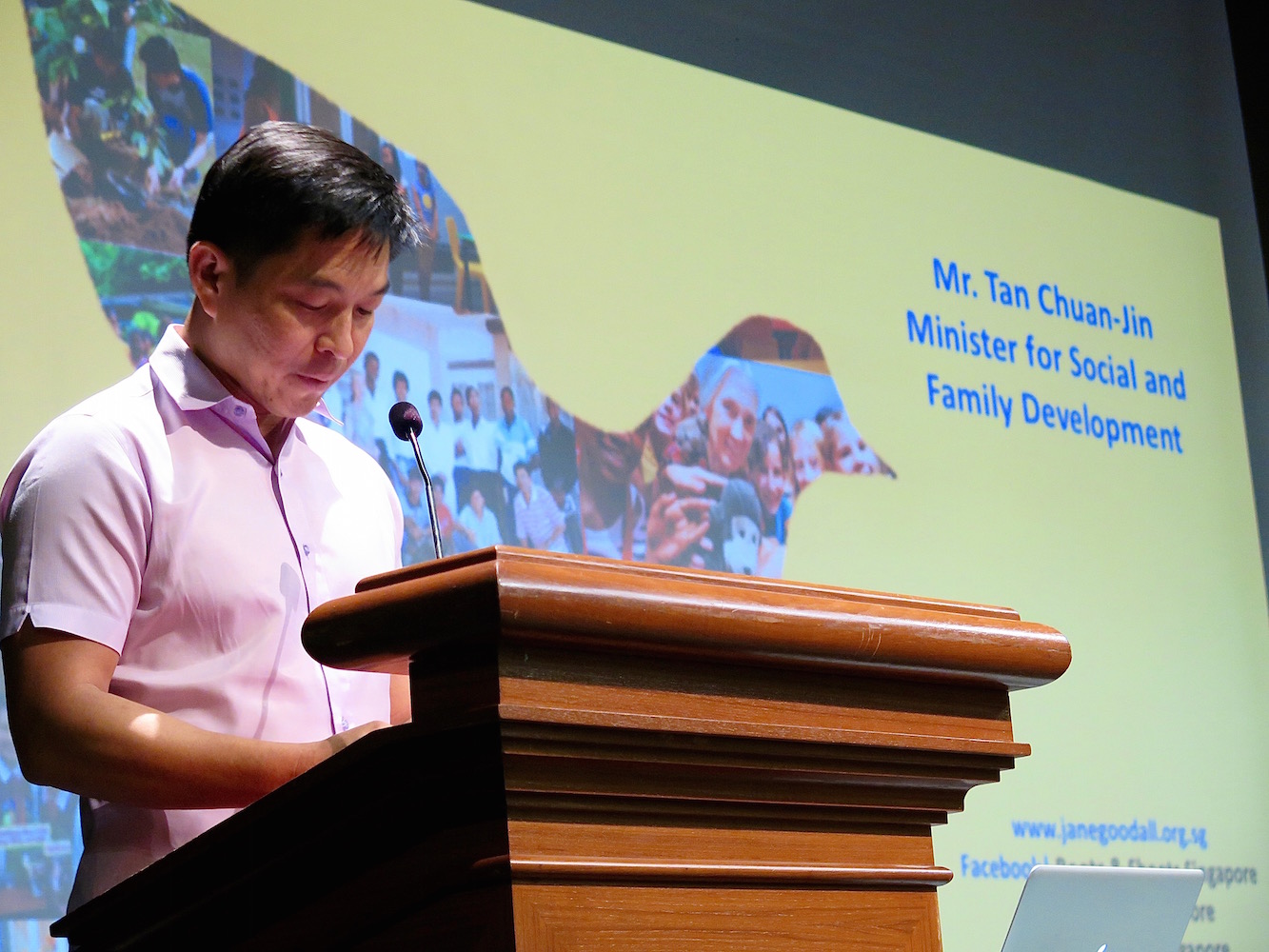

Involved in the festival of Biodiversity, they were given the opportunity to share their research on butterflies during their first major outreach effort. Through that confidence building experience, they realised that
“it is our responsibility to speak up for nature.”
The third presentation by Miss Joyce and Mr Travis Tan from the Singapore Chinese Girls School Integrated Programme shared about their schools Eco-Literacy Module. One of the pillars of the Integrated Programme exclusively provided secondary two Integrated Programme students with modules targeted towards sustainability. They explained how they’ve adopted the Roots & Shoots framework of KCA – Knowledge, Compassion and Action in their modules.
Learning about the supply chain in goods manufacturing, Bees, Kopi Luak and climate change are examples of what the students are thought.
“All these activities ensure that as they move up to higher levels, this may sow the seeds for them to campaign for a greater cause”,
as quoted by Mr. Tan who continued to introduce examples of topics of past student projects such as Sea Turtle conservation, protection of Snow Leopards, disposal of plastics into oceans, students campaigning against deforestation, rising water levels in Venice and the EU migrant crisis.
The teaching duo ended their presentation by reciting a quote from Dr. Jane Goodall herself,
“We have a responsibility toward the other life-forms of our planet whose continued existence is threatened by the thoughtless behaviour of our own human species. Environmental responsibility – for if there is no God, then, obviously, it is up to us to put things right.”
Lastly, the fourth and final presenter Mr. Brian from the Singaporean American Middle School, a teacher and the schools R&S advisor for the past 8 years was introduced. One of the oldest Singapore Roots & Shoots members, Mr. Brian begins his presentation on his school’s community outreach programme.
Referring to his trip to Ecuador at the age of 27, Mr. Brian revealed how he stood up to a tourist who flicked a cigarette bud into the same bushes as the Finches he was observing.
“From this experience, I realised we can`t be quiet about the things that are not right.”
“Deep inside, every one of us has a voice to speak out and we need to learn how to do it.”
were quotes from Mr. Brian on his beliefs on conservation.
Displaying his confidence in Roots & Shoots members and their amazing efforts, he highlights how they “are the stewards who are holding things together and giving hope to the adults out there that are worried they left their children with a world that is beyond repair. You are the hope that things can get better.”
More than ever this year, Mr Brian is teaching his students that besides their projects to speak their mind on what needs to be done and stand up for injustices made against the environment.
Over the last year, his club has been learning about the plight of migrant workers in Singapore. A guest lecture by the Humanitarian Organisation for Migration Economics (HOME), inspired his students from the R&S club to return to their classroom with the intention of helping those in the domestic workers’ shelter. Students emailed the organisation to suggest organising a picnic for the workers. The students began planning the itinerary of the picnic, preparing the food and one student by the name of Ainsley took the liberty of preparing a gift basket for each worker. They even organised a dance lesson due to their common love for dancing. It soon became the highlight of the picnic.
Mr Brian leaves the audience with
“a message of hope and one of calling. Calling to you to use your ears to hear people`s voices. Use your eyes to witness the injustices and your voice to speak out against them. Finally, use your heart to connect with one another.”
The presentations conclude and Kyle, the student emcee, invites Dr. Jane Goodall on stage to deliver her keynote address.
Dr. Jane Goodall wishes the audience a good afternoon as she explains her excitement over the growth of Roots & Shoots in Singapore and the raised awareness of living in harmony with nature. Dr. Jane greets the audience with her famous chimpanzee call.
“I want to say that, going through my life it’s become obvious to me the importance of people along the road who give you a helping hand. We can`t do anything on our own.”
explains Dr. Jane before she begins to share with the audience how the wise ways of her mother who raised her had enabled her journey. Born loving animals, her supportive mother was a key point in which Dr. Jane continues to utilise to emphasise the importance of supporting one`s children in whatever interests them.
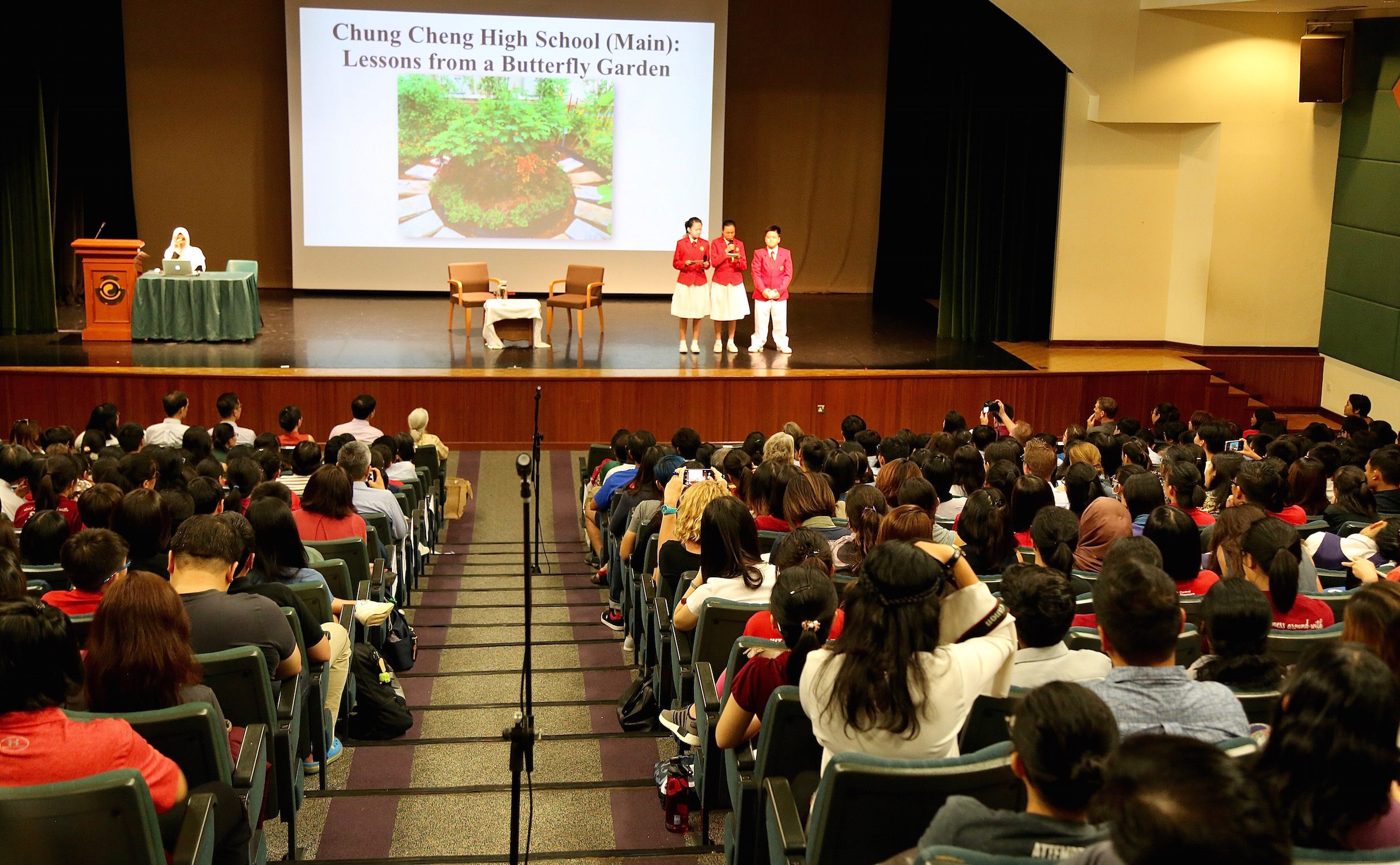
Her dream to explore Africa began when she had read about Tarzan, the King of the Jungle. She was so enthralled by his adventures and decided that when she was older, she would travel to Africa, live with wild animals and write books about it. Everyone laughed at her ridiculous and impossible idea. World War Two was raging, she didn’t have much money and furthermore, she was a female. However, her mother believed in her. The message of encouragement from her beloved mother is what she carries around with her and always shares when she travels the world.
Dr Jane did rather well in school but was unable to enter university due to insufficient funds. Instead, she got a job as a secretary in London. It wasn’t until she was invited to Kenya by a friend that she was able to escape her boring job. Waitressing to finance her trip, the travel took more than 3 weeks by boat. Dr Jane`s first docked in Cape Town before travelling to Kenya to live on her friend’s farm.
After 2 months of living in Kenya, Dr Jane met Dr Louis Leakey, a renowned palaeontologist who was also a curator at the Natural History Museum of London. Dr Leakey was responsible for the search of fossilised remains of our first ancestors in East Africa and just so happened to be in need of a secretary to which Dr Jane accepted. Dr Leakey then decided that Jane would study chimpanzees at the Gombe National Park in Tanzania.
Patience that fuelled her passion for 4 months in Tanzania provided Dr Jane with a breakthrough observation. One of the chimpanzees, affectionately named David Greybeard by Dr Jane, had become accustomed to her presence. He soon demonstrated that Chimpanzees could make tools just like humans. The above breakthrough allowed Dr Leakey to secure funding from National Geographic after six months for Dr Jane`s time in Africa. David Greybeard also enabled her meeting with other Chimpanzees. Dr Jane soon realised that each Chimpanzee had a distinct personality of its own. 2 years of observing chimpanzees in Tanzania lead to Dr Leakey arranging for her study of Ethology at Cambridge University to earn a PhD.
Attending a conference in 1986 that highlighted the disappearance of forests across Africa, Dr. Jane left as an activist, “I knew I had to do something. I didn’t know what.”
Travelling aided her realisation that helping people living better lives was the first step to helping the environment. An initiative called “Take Care” was inducted and formed the core element of the research that allowed villagers involved to share their findings with their own villages. After the success of the initiative, it was in 1991 that “Roots & Shoots” was formed with 12 high-school students from Tanzania.

“Understanding the interconnectedness of things around the planet. Yes, our groups would choose themselves three projects to make the world a better place for people, for animals and for the environment we all share.”
The group of 12 high-school students grew across Tanzania and soon globally expanded till the formation of 100th group, the most recent Roots & Shoots group from Malawi. Impacting the lives of people of all ages and backgrounds for the entirety of their lives, Roots & Shoots has breathed life into a movement that has already brought about change to the world we call home.
Thanking everyone for listening, those that presented, those present and those who have volunteered their time to the event, Dr Jane concluded her keynote speech by wishing everyone a great National Day.
And with that, a 5-minute Q&A section began. Answering an array of questions such as the advice she would give to young girls who wished to succeed in the World, to the use of technology and even her opinion of the possibility of Apes evolving to those depicted in the Dawn of the Planet of the Apes, a video of Dr Jane during her trip to witness the release of the 15th Chimpanzee, Wounda, onto Tchindzoulou Island was played. The session came to an end and Dr Jane was led out to visit the various booths along the entrance to the auditorium.

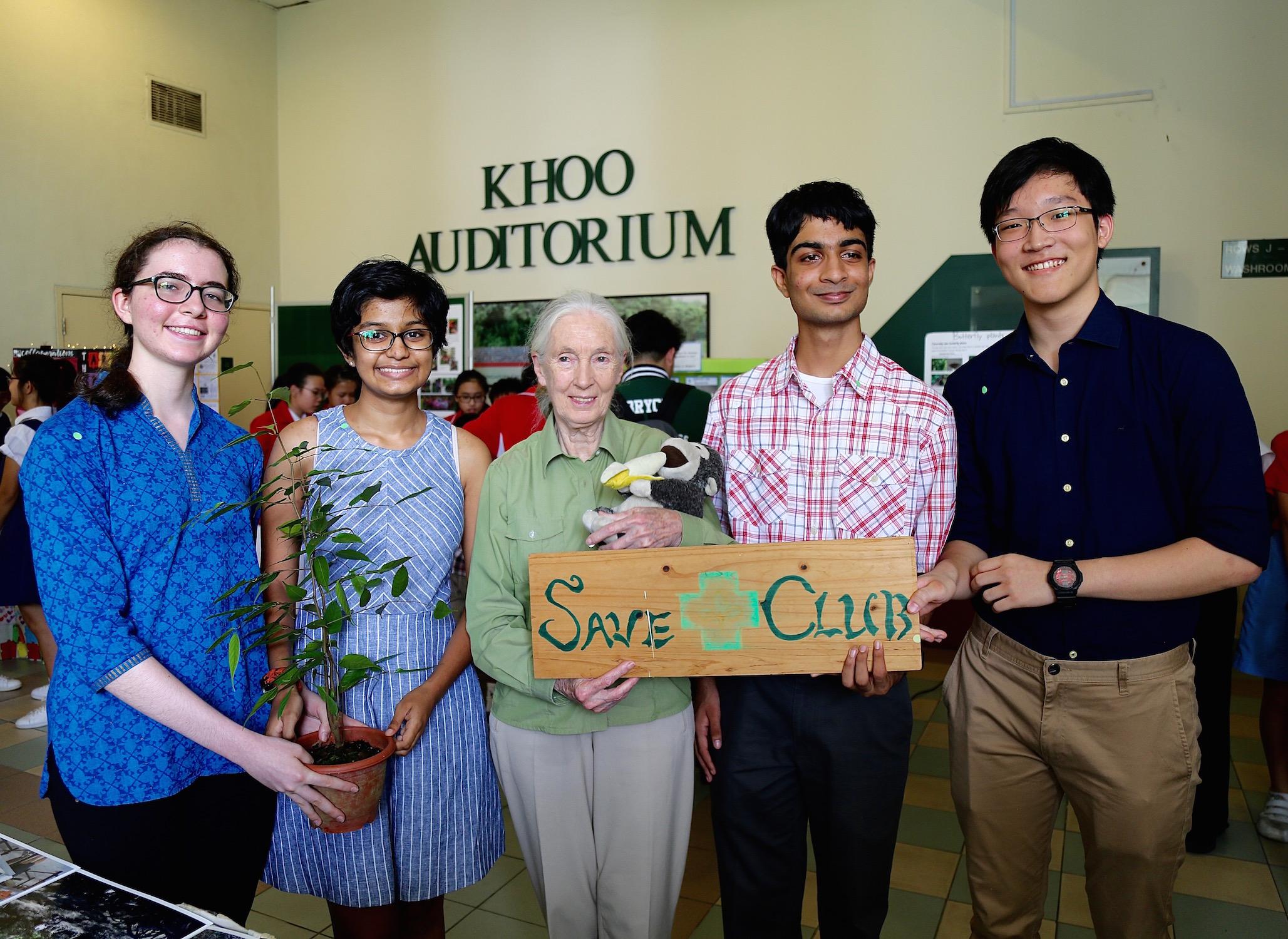
During her visit to the booths, various student leaders were escorted to the meeting room in which they would have a personal session with Dr. Jane. Livestreamed on Facebook and Twitter, the session was one filled with a question by the student’s leaders. For example, if she ever felt like giving up on her journey, what inspired her to keep going, how to convey to others the message of conservation and why she had decided to travel to Africa and had first taken interest in South African animals. Students also had the fortune of taking photos with the great Dr. Jane.
Before taking her leave, Dr. Jane bid everyone a farewell, thanking them all for the great session. As guests left the venue, a delight from the inspiring time they had shared with Dr. Jane was plastered on each of their faces. The booth masters and volunteers began to pack-up as the final official event of Dr. Jane`s visit, the Roots & Shoots conference had in fact finally come to an end.
Written by Andrea Vincent.
